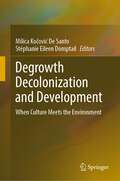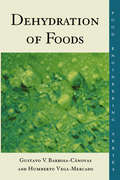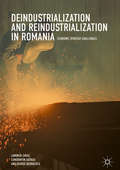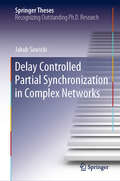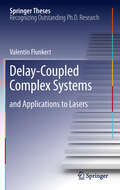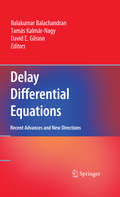- Table View
- List View
Degradations and Instabilities in Geomaterials (CISM International Centre for Mechanical Sciences #461)
by Félix Darve Ioannis VardoulakisThis book presents the most recents developments in the modelling of degradations (of thermo-chemo-mechanical origin) and of bifurcations and instabilities (leading to localized or diffuse failure modes) taking place in geomaterials (soils, rocks, concrete). Applications (landslides, rockfalls, debris flows, concrete and rock ageing, etc.) are discussed in detail.
A Degree in a Book: Everything You Need to Know to Master the Subject - in One Book! (A Degree in a Book)
by Dr Sten OdenwaldA Degree in a Book: Cosmology is the perfect introduction to cosmology, astronomy and astrophysics. Written by one of NASA's leading astronomers and educators, this book provides you with the essential foundations for understanding the science behind the universe we live in. It will help you answer questions such as: • How do we know the universe is expanding?• What is the theory of relativity?• How does the Higgs mechanism work?• What is dark matter?Filled with helpful diagrams, suggestions for further reading and easily digestible history sections, this book makes it easier than ever to understand the workings of the universe. Featuring the most important ideas in the field, including the Theory of Relativity, the Standard Model, Loop Quantum Gravity, and Supersymmetry, it covers the whole breadth of cosmology.
Degrowth Decolonization and Development: When Culture Meets the Environment
by Milica Kočović De Santo Stéphanie Eileen DomptailDegrowth Decolonization and Development reveals common underlying cultural roots to the multiple current crises. It shows that culture is an essential sphere to initiate fundamental changes and solutions as it brings about transformative imaginaries on a theoretical, political and practical level. The book focusses on the interplay between culture and the environment, society and the economy. It provides a critique of concepts associated with the term “Development” and reveals knowledge and theories outside the comfort zone of the mainstream Western theoretical landscape, which will certainly be instrumental in the decolonization of both development theories and practices. The book convincingly reveals the large array of domains, which, when interpreted from a decolonization and Degrowth perspective, can be managed through logics of environmental justice, social equity and equality, and generate societally more desirable outcomes. The book presents a multidisciplinary perspective on the contemporary global crises and features interdisciplinary analyses thereof through the lenses of cultural studies, critical development studies, political economy, eco-feminist political ecology, anthropology and sociology. Degrowth Decolonization and Development unveils the fundamental role of the dichotomies characterizing the Western modern development paradigm in shaping today’s actions, and especially the dichotomies of Global North and Global South, Centre and Periphery, Developed and Developing/Underdeveloped, Man and Nature. Degrowth Decolonization and Development addresses all researchers and activists interested in sustainability transformation and decolonization processes in Development studies. Degrowth Decolonization and Development is structured as a collection of seven original case studies. These are authored by researchers who met when presenting their work in Decolonization and Degrowth panels from the ISEE-ESEE-Degrowth Conference, Manchester, July 5-8, 2021, and the 8th International Degrowth Conference in The Hague, Netherlands, August 24-28, 2021. The concluding chapter proposes a synthesis identifying key concepts and steps in cultural change for the decolonization of the Western worldview towards “pluriverse” alternatives. The book traces future imaginaries for modelling future new systemic solutions and a needed radical change.
Dehalogenation: Microbial Processes and Environmental Applications
by Max M. Häggblom and Ingeborg D. BossertHalogenated organic compounds constitute one of the largest groups of environmental chemicals. The industrial production of new halogenated organic compounds has increased throughout the last century peaking in the 1960s, and continuing in widespread use today. Organohalides are integral to a variety of industrial applications, including use as solvents, degreasing agents, biocides, pharmaceuticals, plasticizers, hydraulic and heat transfer fluids, and intermediates for chemical synthesis, to name a few. It is important to recognize the beneficial aspects of halogenated organic compounds, as well as their potentially deleterious impact on the environment and health. Recognition ofthe adverse environmental effects ofmanytypes oforganohalide compounds has led to efforts to reduce or eliminate the most problematic ones. Although organohalide compounds are typically considered to be anthropogenic industrial compounds, they have their counterpart in several thousands of natural biogenic and geogenic organohalides, representing most classes of organic chemicals. Natural sources account for a significant portion of the global organohalogen budget. This volume authored by recognized experts in the field provides a current perspective on how both natural and synthetic organohalides are formed and degraded, and how these processes are incorporated into a global halogen cycle. The focus is on microbial processes, since these play a major role both in the production and degradation, i. e. , cycling of halogenated organic compounds inthe environment. This book is organized into five parts. Part I, Introduction, provides a global perspective on the issues of organohalides and their fate in the environment.
Dehnungsmessstreifen
by Stefan KeilDas vorliegende Fachbuch ist ein Kompendium der DMS-Entwicklung, deren letzte Jahrzehnte der Autor selbst mitgestaltet hat. Es stellt für den Praktiker vor Ort, der Installationen für zuverlässige Messungen und die Messungen selbst ausführen will, eine kompakte Arbeitsanweisung dar. Für den Experten, der Probleme analysieren, Lösungen konzipieren und Messergebnisse auswerten muss, ist das Buch mit seinem ausführlichen Sachverzeichnis ein unverzichtbares Nachschlagewerk. Für den Lernenden, den Neueinsteiger in das Fachgebiet, der sich mit Möglichkeiten und Grenzen der DMS-Technik vertraut machen will, wird das Buch ein hilfreicher Ratgeber sein. Der Inhalt beschränkt sich nicht nur auf Technologie und Anwendung der DMS, sondern behandelt in ausführlicher Form die für die Auswertung gemessener Dehnungen erforderlichen Algorithmen zur Ermittlung von Spannungen.
Dehydration of Foods (Food Engineering Series)
by Humberto Vega-MercadoCompletely up-to-date and organized for easy use, this one-of-a-kind reference integrates basic concepts with hands-on techniques for food dehydration. It discusses a wide range of scientific and technical information, from the physical, chemical, and microbiological changes in food dehydration to its packaging aspects.
Dehydrogenation Reactions with 3d Metals (Topics in Organometallic Chemistry #73)
by Basker SundararajuIn this book recent developments in dehydrogenation reactions catalyzed by 3d-metals are discussed. With continue efforts to develop sustainable chemical production the discovery of new catalysts and catalytic procedures for (de)hydrogenation reactions are a subject of great interest to the chemistry community. Additionally, (de)hydrogenation reactions enable the creation of closed-loop production cycles that support a circular economy. The chapters presented include the synthesis of heterocycles and tandem-multicomponent (three or more) reactions through dehydrogenative strategy, as well as the conversion of ethanol to n-butanol, higher oxidized hydrocarbons like acids, ester, amides from alcohols, α-alkylation of amines, ketones, and amides with alcohols and mechanistic understanding of dehydrogenation reactions with high-valent metals. With contributions from experts in the field, the book is a valuable resource for scholars working in the field of organometallic chemistry, catalysis, medicinal chemistry, as well as researchers in the industry.
Deindustrialization and Reindustrialization in Romania: Economic Strategy Challenges
by Luminița Chivu Constantin Ciutacu George GeorgescuThis book analyses the multidimensional condition of the Romanian industrial landscape, which played host to a multitude of demo-economic, financial, trade, and trans- and inter-sectoral development practices before the intense period of European deindustrialisation. The authors stress the need to recognise the economic importance of industry and renewed investment in infrastructure, tracing its impact on GDP, growth and labour productivity. With a focus on R&D, technological innovations and government funding, this volume highlights a strategy for the reindustrialisation, with consistent enablers, of Romania that can also be applied to other EU countries to ensure positive economic development in the context of new European and international policies.
Deindustrialization and Reindustrialization in Romania: Economic Strategy Challenges
by Luminița Chivu Constantin Ciutacu George GeorgescuThis book analyses the multidimensional condition of the Romanian industrial landscape, which played host to a multitude of demo-economic, financial, trade, and trans- and inter-sectoral development practices before the intense period of European deindustrialisation. The authors stress the need to recognise the economic importance of industry and renewed investment in infrastructure, tracing its impact on GDP, growth and labour productivity. With a focus on R&D, technological innovations and government funding, this volume highlights a strategy for the reindustrialisation, with consistent enablers, of Romania that can also be applied to other EU countries to ensure positive economic development in the context of new European and international policies.
Deinstitutionalisation and After: Post-War Psychiatry in the Western World (Mental Health in Historical Perspective)
by Despo Kritsotaki Vicky Long Matthew SmithThe book relates the history of post-war psychiatry, focusing on deinstitutionalisation, namely the shift from asylum to community in the second part of the twentieth century.After the Second World War, psychiatry and mental health care were reshaped by deinstitutionalisation. But what exactly was involved in this process? What were the origins of deinstitutionalisation and what did it mean to those who experienced it? What were the ramifications, both positive and negative, of such a fundamental shift in psychiatric care? Post-War Psychiatry in the Western World: Deinstitutionalisation and After seeks to answer these questions by exploring this momentous change in mental health care from 1945 to the present in a wide range of geographical settings. The book articulates a nuanced account of the history of deinstitutionalisation, highlighting the constraints and inconsistencies inherent in treating the mentally ill outside of the asylum, while seeking to inform current debates about how to help the most vulnerable members of society.
The Deja Vu Experience (Essays in Cognitive Psychology)
by Alan S. BrownMost of us have been perplexed by a strange sense of familiarity when doing something for the first time. We feel that we have been here before, or done this before, but know for sure that this is impossible. In fact, according to numerous surveys, about two-thirds of us have experienced déjà vu at least once, and most of us have had multiple experiences. There are a number of credible scientific interpretations of déjà vu, and this book summarizes the broad range of published work from philosophy, religion, neurology, sociology, memory, perception, psychopathology, and psychopharmacology. This book also includes discussion of cognitive functioning in retrieval and familiarity, neuronal transmission, and double perception during the déjà vu experience.
The Deja Vu Experience (Essays in Cognitive Psychology)
by Alan S. BrownMost of us have been perplexed by a strange sense of familiarity when doing something for the first time. We feel that we have been here before, or done this before, but know for sure that this is impossible. In fact, according to numerous surveys, about two-thirds of us have experienced déjà vu at least once, and most of us have had multiple experiences. There are a number of credible scientific interpretations of déjà vu, and this book summarizes the broad range of published work from philosophy, religion, neurology, sociology, memory, perception, psychopathology, and psychopharmacology. This book also includes discussion of cognitive functioning in retrieval and familiarity, neuronal transmission, and double perception during the déjà vu experience.
The Déjà Vu Experience (Essays in Cognitive Psychology)
by Anne M. Cleary Alan S. BrownThe Déjà vu Experience, Second Edition covers the latest scientific discoveries regarding the strange sense of familiarity most of us have felt at one time or another when doing something for the first time. The book sheds light on this mysterious phenomenon, considering the latest neurophysiological investigations and research on possible reasons why déjà vu is often associated with a sense of predicting the future or knowing what happens next. In addition to summarizing the major historical and contemporary theoretical approaches to the déjà vu experience, this book aspires to stimulate additional research on this curious subjective phenomenon. Drawing on research from a range of fields including psychology, philosophy, and religion, it aims to demystify some of the more unsettling, spooky-seeming aspects of the déjà vu experience, elucidating possible mechanisms and underlying reasons for its occurrence. This edition has been thoroughly updated throughout to include over 200 new professional articles and book chapters related to déjà vu that have been published in the 18 years since the original book. By placing the scientific study of déjà vu within its historical context and covering a broad range of perspectives on the subject, this title will be invaluable to upper-level undergraduates, postgraduates, and researchers of Cognitive Psychology, specifically those focusing on Memory Phenomena.
The Déjà Vu Experience (Essays in Cognitive Psychology)
by Anne M. Cleary Alan S. BrownThe Déjà vu Experience, Second Edition covers the latest scientific discoveries regarding the strange sense of familiarity most of us have felt at one time or another when doing something for the first time. The book sheds light on this mysterious phenomenon, considering the latest neurophysiological investigations and research on possible reasons why déjà vu is often associated with a sense of predicting the future or knowing what happens next. In addition to summarizing the major historical and contemporary theoretical approaches to the déjà vu experience, this book aspires to stimulate additional research on this curious subjective phenomenon. Drawing on research from a range of fields including psychology, philosophy, and religion, it aims to demystify some of the more unsettling, spooky-seeming aspects of the déjà vu experience, elucidating possible mechanisms and underlying reasons for its occurrence. This edition has been thoroughly updated throughout to include over 200 new professional articles and book chapters related to déjà vu that have been published in the 18 years since the original book. By placing the scientific study of déjà vu within its historical context and covering a broad range of perspectives on the subject, this title will be invaluable to upper-level undergraduates, postgraduates, and researchers of Cognitive Psychology, specifically those focusing on Memory Phenomena.
Delamination Buckling of Composite Materials (Mechanics of Elastic Stability #14)
by L. KachanovLIOn Delamination of Laminated Composites (a) Fiber-Reinforced Composites Considerable technological advances in the production of high-strength fibers (graphite, boron, etc.) have led to a wide use of light high-strength composite materials (graphite epoxy, boron-epoxy, etc.). It is expedient, to make thin walled composite rods, plates, and shells from such materials. Plates can be made by bonding a set of unidirectional thin fiber layers, Fig.l.l. Such plates are orthotropic, as a rule. A random short-fiber composite is shown in Fig. 1.2. Fiber-reinforced composites are widely used in thin-walled aircraft structures because of their specific high strength. For example, the graphite-epoxy composite is characterized by a unidirectional tensile strength of 1.4 GPa while the density is 1.6 Mg/rrt? . For comparison, we may take a steel (steel 4340) whose corresponding properties are identified by values like 1.2 GPa and 7.8 Mg/rrt? . 1. INTRODUCTION Figure 1.1 2 1.1. On Delamination of Laminated Composites Figure 1.2 3 1. INTRODUCTION It is characteristic for laminated plastic material to possess a fairly low bonding. Therefore, low-velocity impacts and defects in manufacturing lead to local delamination. (b) Linear Problems of Delamination Buckling Delamination can significantly reduce the compressive strength and stiffness of the laminate. Local delamination can be considered as a crack in the bond. Under buckling there appears a high interlaminate stress at the crack edge that leads to a spreading of the crack. Delamination growth can lead to structural instability.
Delamination in Wood, Wood Products and Wood-Based Composites
by Voichita BucurIn the last quarter century, delamination has come to mean more than just a failure in adhesion between layers of bonded composite plies that might affect their load-bearing capacity. Ever-increasing computer power has meant that we can now detect and analyze delamination between, for example, cell walls in solid wood. This fast-moving and critically important field of study is covered in a book that provides everyone from manufacturers to research scientists the state of the art in wood delamination studies. Divided into three sections, the book first details the general aspects of the subject, from basic information including terminology, to the theoretical basis for the evaluation of delamination. A settled terminology in this subject area is a first key goal of the book, as the terms which describe delamination in wood and wood-based composites are numerous and often confusing. The second section examines different and highly specialized methods for delamination detection such as confocal laser scanning microscopy, light microscopy, scanning electron microscopy and ultrasonics. Ways in which NDE (non-destructive evaluation) can be employed to detect and locate defects are also covered. The book’s final section focuses on the practical aspects of this defect in a wide range of wood products covering the spectrum from trees, logs, laminated panels and glued laminated timbers to parquet floors. Intended as a primary reference, this book covers everything from the microscopic, anatomical level of delamination within solid wood sections to an examination of the interface of wood and its surface coatings. It provides readers with the perspective of industry as well as laboratory and is thus a highly practical sourcebook for wood engineers working in manufacturing as well as a comprehensively referenced text for materials scientists wrestling with the theory underlying the subject.
Delaware Seminar in the Foundations of Physics (Studies in the Foundations, Methodology and Philosophy of Science #1)
by Mario BungeThis volume collects the lectures on the foundations of physics given by eleven scientists at the University of Delaware. It is neither an anthology of disconnected items nor a smoothly running textbook but rather a progress report on a neglected yet vital area of basic physical research, namely foundations research. The investigation into the foundations of any branch of science is neither loose speculation nor popular science: it is an aspect of scientific research - in fact the deepest-searching part of basic research. Con sequently it must be carried out by the scientist himself. Thus whether the time concept is a numerical variable or a function, whether particle mechanics is the primary mechanical theory or a particular case of continuum mechanics, whether transformation formulas are laws of nature or links between equivalent descriptions, whether thermodynamics has been fully reduced to statistical mechanics, whether the field concept is dispensable, whether the covariance principle is a law or a regulative principle, whether quantum mechanics is completely detached from classical physics or contains fragments of it, whether it has annihilated the physical object or given a more complex picture of it, and to which extent are the field variables measurable - all these are technical questions demanding a careful analysis of pieces of recent basic research. Yet all of these problems and indeed all questions in foundational research are philosophical as well as scientific.
Delay and Uncertainty in Human Balancing Tasks (Lecture Notes on Mathematical Modelling in the Life Sciences)
by Tamás Insperger John MiltonThis book demonstrates how delay differential equations (DDEs) can be used to compliment the laboratory investigation of human balancing tasks. This approach is made accessible to non-specialists by comparing mathematical predictions and experimental observations. For example, the observation that a longer pole is easier to balance on a fingertip than a shorter one demonstrates the essential role played by a time delay in the balance control mechanism. Another balancing task considered is postural sway during quiet standing. With the inverted pendulum as the driver and the feedback control depending on state variables or on an internal model, the feedback can be identified by determining a critical pendulum length and/or a critical delay. This approach is used to identify the nature of the feedback for the pole balancing and postural sway examples. Motivated by the question of how the nervous system deals with these feedback control challenges, there is a discussion of ‘’microchaotic’’ fluctuations in balance control and how robust control can be achieved in the face of uncertainties in the estimation of control parameters. The final chapter suggests some topics for future research.Each chapter includes an abstract and a point-by-point summary of the main concepts that have been established. A particularly useful numerical integration method for the DDEs that arise in balance control is semi-discretization. This method is described and a MATLAB template is provided.This book will be a useful source for anyone studying balance in humans, other bipedal organisms and humanoid robots. Much of the material has been used by the authors to teach senior undergraduates in computational neuroscience and students in bio-systems, biomedical, mechanical and neural engineering.
Delay Compensation for Nonlinear, Adaptive, and PDE Systems (Systems & Control: Foundations & Applications)
by Miroslav KrsticShedding light on new opportunities in predictor feedback, this book significantly broadens the set of techniques available to a mathematician or engineer working on delay systems. It is a collection of tools and techniques that make predictor feedback ideas applicable to nonlinear systems, systems modeled by PDEs, systems with highly uncertain or completely unknown input/output delays, and systems whose actuator or sensor dynamics are modeled by more general hyperbolic or parabolic PDEs, rather than by pure delay. Replete with examples, Delay Compensation for Nonlinear, Adaptive, and PDE Systems is an excellent reference guide for graduate students, researchers, and professionals in mathematics, systems control, as well as chemical, mechanical, electrical, computer, aerospace, and civil/structural engineering. Parts of the book may be used in graduate courses on general distributed parameter systems, linear delay systems, PDEs, nonlinear control, state estimator and observers, adaptive control, robust control, or linear time-varying systems.
Delay Controlled Partial Synchronization in Complex Networks (Springer Theses)
by Jakub SawickiThe focus of this thesis are synchronization phenomena in networks and their intrinsic control through time delay, which is ubiquitous in real-world systems ranging from physics and acoustics to neuroscience and engineering. We encounter synchronization everywhere and it can be either a helpful or a detrimental mechanism. In the first part, after a survey of complex nonlinear systems and networks, we show that a seemingly simple system of two organ pipes gives birth to complex bifurcation and synchronization scenarios. Going from a 2-oscillator system to a ring of oscillators, we encounter the intriguing phenomenon of chimera states which are partial synchrony patterns with coexisting domains of synchronized and desynchronized dynamics. For more than a decade scientist have tried to solve the puzzle of this spontaneous symmetry-breaking emerging in networks of identical elements. We provide an analysis of initial conditions and extend our model by the addition of time delay and fractal connectivities. In the second part, we investigate partial synchronization patterns in a neuronal network and explain dynamical asymmetry arising from the hemispheric structure of the human brain. A particular focus is on the novel scenario of partial relay synchronization in multiplex networks. Such networks allow for synchronization of the coherent domains of chimera states via a remote layer, whereas the incoherent domains remain desynchronized. The theoretical framework is demonstrated with different generic models.
Delay-Coupled Complex Systems: and Applications to Lasers (Springer Theses)
by Valentin FlunkertThis work addresses time-delay in complex nonlinear systems and, in particular, its applications in complex networks; its role in control theory and nonlinear optics are also investigated. Delays arise naturally in networks of coupled systems due to finite signal propagation speeds and are thus a key issue in many areas of physics, biology, medicine, and technology. Synchronization phenomena in these networks play an important role, e.g., in the context of learning, cognitive and pathological states in the brain, for secure communication with chaotic lasers or for gene regulation. The thesis includes both novel results on the control of complex dynamics by time-delayed feedback and fundamental new insights into the interplay of delay and synchronization. One of the most interesting results here is a solution to the problem of complete synchronization in general networks with large coupling delay, i.e., large distances between the nodes, by giving a universal classification of networks that has a wide range of interdisciplinary applications.
Delay Differential Equations: Recent Advances and New Directions
by Balakumar Balachandran Tamás Kalmár-Nagy David E. GilsinnDelay Differential Equations: Recent Advances and New Directions cohesively presents contributions from leading experts on the theory and applications of functional and delay differential equations (DDEs). Students and researchers will benefit from a unique focus on theory, symbolic, and numerical methods, which illustrate how the concepts described can be applied to practical systems ranging from automotive engines to remote control over the Internet. Comprehensive coverage of recent advances, analytical contributions, computational techniques, and illustrative examples of the application of current results drawn from biology, physics, mechanics, and control theory. Students, engineers and researchers from various scientific fields will find Delay Differential Equations: Recent Advances and New Directions a valuable reference.
Delay Effects on Stability: A Robust Control Approach (Lecture Notes in Control and Information Sciences #269)
by Silviu-Iulian NiculescuThis monograph is devoted to the effect of delays on the stability properties of dynamical systems. Stability regions with respect to the delay parameters are considered, and some sufficient characterizations are proposed. This monograph addresses general delay problems and offers solutions in some cases. In other cases, approximations of the stability regions can be proposed. The interpretation of delays as uncertainty allows the authors to use the advances in robust control and robust convex optimization to solve or to approximate the solutions of the corresponding problems.



